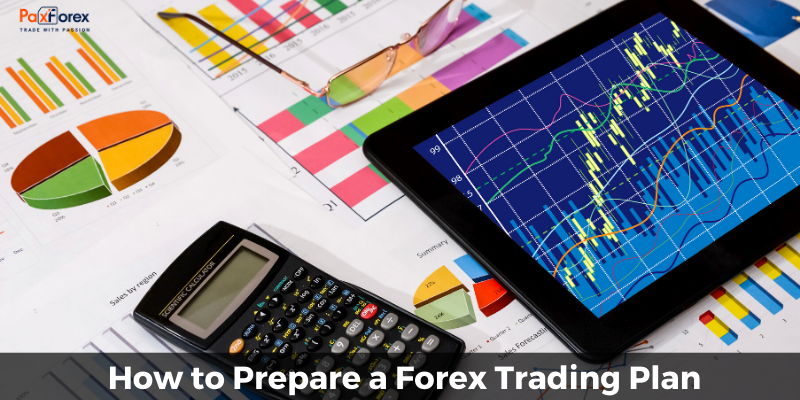
While trading on the financial market, any trader faces the problem of planning positions. Quite a lot of already advanced traders pay great attention and spend a lot of effort to build their trading strategy, but do not know how to fully use it. As a result, even with the existing excellent trading strategy, time after time there are losses, which lead to the fact that the trader starts to change his strategy or refuse it, switching to another one.
The vast majority of those who learn to trade on the market pass-through this stage. Depending on the degree of awareness of the problem, at this stage, you can be stuck for a long time, because you feel that you do not have a good enough trading system and need to find a suitable and profitable one. However, the main reason for failures lies not in the trading strategy plane - you can have any trading strategy you want - but in the fact that there is no planning element in trading. Simply put, there is an algorithm of actions in the form of a strategy, but there is no trading plan - where and how to apply this strategy.
Each of the trades placed must be calculated in all aspects - from which instrument, how, and when to open it, to the logical conclusion. It is what the trading plan is meant for.
What is a Forex Trading Plan?
A Forex trading plan is an algorithm of actions that must be followed during the trading day. It is difficult to imagine a company without a business plan written on paper. So in trading without a trading plan, all your actions are doomed to failure. The lack of a Forex trading plan is one of the reasons why traders lose money. Another important point is that your trading plan should not be in your head, but written down on paper. You would probably be very surprised if you found out that an entrepreneur does not have a business plan or keeps everything in his head. You must understand that no business can exist without a business plan written down in advance. In trading, you need the same approach if you want to become a professional trader and earn a living by doing so. Take a few hours and write on paper a detailed trading plan, so that you can always see it before your eyes, and you can look at it to understand whether it is worth entering the market now and when to fix the profit or loss.
Making a Forex Trading Plan

Trading on stock and currency markets has its own rules and regularities. Contrary to common misconceptions, this is not chaos, but a complex ordered system. Therefore, the most successful traders track their work and create scenarios that reflect different market conditions.
A trader's trading plan is individual and depends on your strategy and trading style. If you are a scalper, the trading plan of a trader who trades on daily charts and vice versa will not work for you. We can only give general recommendations when drawing up a Forex trading plan, and then you should think through all its elements yourself. Subsequently, you can go back to the trading plan and refine it.
Creating a trading plan is not that difficult. The number one thing you should do is to decide how often you are going to trade. To do that we recommend you go through your trading history and see the number of positions placed per day/week/month, as well as to consider the common duration of each position. It is a very important stage since your plan should explicitly demonstrate the time measurement you're going to be applying in your trading strategy. For example, a day trader`s trading plan should be considered over 24 hours.
In case you hold positions for a couple of days and only then close them, then If your positions tend to be close a few days after they have been opened, it is better to prepare a plan for a week. All of that plays the most important role in creating a trading plan as it is basic knowledge. It is vital to understand how to develop a Forex trading plan. Defining the time measurement of the trading will help you decide if you need a weekly or daily dimension.
Of course, in some cases, traders will need to consider a monthly plan, but that doesn't happen often. Let's say you prefer intraday trading consequently, we should take into account a day as a unit of time for the trading plan. Since we have discovered that, we should now add some restrictions to our plan. Among traders, there is an unwritten rule - to take a number of your successful positions and later multiply the amount by 1.2. In other words, if, on average, a trader executes 20 positions a day, yet only six trades are winning ones, a trader should not trade more than seven trades a day.
Less opportunities
Usually, in our mentality, once we hear someone saying that something is providing less opportunities, we are most likely to avoid it considering it like something worse. But when we talk about the Forex trading plan, it is not so. Creating a working trading plan for Forex, we have to remember that any trading opportunity over there will not always be winning. Once you realize (and acce[pt that fact) that it can result in losses too, then we are on the same page and proceed to work on the Forex trading plan.
Deciding to control/limit the number of positions a day, you will start to pay much more attention to every order placed. The logic behind it is crystal clear - knowing that you have, let`s say, only five trades to open today, you will choose them very thoroughly. You will check everything several times not only because you know that you have a limited number of attempts, but because with each losing trade you will:
see your account balance shrink;
let opportunities to place winning orders slip away.
Lower chance for emotional trading
One more benefit of limiting your daily (weekly) trading activity to a specified number of trades is the possibility to bypass emotional trading. This problem is extremely common among Forex traders, especially beginners since they always try to wager the losses, and all traders have faced that issue, believe it or not. Most of them rush into trading and result in blowing all the deposit, instead of taking some time to calm down and make an informed decision. It is done like that - being upset by a previous loss trader tries to take revenge on the market, and starts to increase the trading volume, place more losing positions. The result is known beforehand. The only way to avoid such situations is the development of the Forex trading plan and sticking to it.
How to Prepare a Forex Trading Plan

Now after we have discussed why creating the Forex trading plans is so essential for traders, and have considered the importance of limiting the number of trades you can place per day/week. Now we will discover some more aspects that should be taken into account while preparing the trading plan.
Entry signals
Probably each trader was overwhelmed by the same feelings watching the price skyrocketing or dropping, with the irresistible desire to jump in with both feet being sure that this is the time to make real money. In a moment you look at the placed order with no idea how to handle it now, what profit to expect, and has just happened. Sounds familiar? 99% of traders were in such a situation, particularly on the very first stage of familiarizing yourself with trading.
That is why the Forex trading plan must cover a precise explanation of the entry signals the trader is plotting to employ in the trading strategy. Right after these "beacons'' are outlined and written down, make sure to rigorously stick to them. Naturally, before-mentioned signals have to be as clear as possible to avoid any unpleasant consequences. Strictly speaking, in case there are four price action patterns implemented in your trading strategy, all four of them must be added to the market entry signal of your Forex trading plan.
Exit signals
The same situation is with the market exit signals - all traders need to have a clear picture of what the exit signal is when creating a Forex trading plan. Yes, placing orders in time and choosing the proper assets is vital, but without closing the position in time, all of that will make no sense. Exit signals may even be the most important aspect here since trading is about making money. Consequently, without smart market exit, you risk closing the position too early and missing the opportunity to get bigger profits being impatient or just lose it all waiting for too long.
If your trading plan includes exit signals, you will not find yourself in such situations. Any plan will be incomplete without marker exit signals since traders need to have a crystal clear understanding of what profit is foreseen from each trade, otherwise, the feeling of uncertainty will mess the whole trading up.
Stop-loss (SL) and a Take-profit (TP)
Since we have learned how essential entry and exit signals are when it comes to developing the Forex trading plan. They help you strictly adhere to your existing trading strategy, as well as exclude the likelihood of emotional interruptions into the trading process itself. One more essential aspect here is the setting Stop-Loss and Take-Profit for every position.
In fairness, we cannot but mention that setting Stop-Loss levels is much more crucial than Take-Profit. So, when preparing a Forex trading plan, all organized and serious traders have to keep in mind the necessity of placing Stop-Loss. It applies to every position, without deviations and excuses.
Apart from that, the Forex trading plan should include predefined Stop-Loss levels. Reasonably they may vary from asset to asset, but it must be there. On the other hand, predefining Take-Profit is not so significant. Nevertheless, if you want to develop the best Forex trading plan, it is advised to determine the Take-Profit levels prior to placing any position and add that to your trading plan.
Reasons for changing the trading plan
Depending on the trading system, the points of the trading plan may vary. Once the trade is closed, it is necessary to conduct a comprehensive analysis: the correctness of opening and closing a position, the result of the trade itself. Also, it is necessary to note arising thoughts and emotions, to reveal positive and negative sides and to note the moments on which you need to work. It is important to remember that the situation in the Forex market often changes quickly and dramatically, especially after the release of important economic data or statements of heads of central banks. In such a case, your trading plan should be revised following the current market situation, and another one should be drawn up, per which you need to work.
The Faults With Trading Plans
For an effective trading plan to be drawn up, it is necessary to write down all the points on paper or in electronic records. First, all points of the trading plan will be at the right moment before the eyes, and secondly, this method allows better remembering and assimilating of any information. Already It is necessary to locate a trading plan on a desktop so that it all time gets in a field of sight. In such a way, it will always remind you that there is a plan of action, and it is necessary to adhere to it by all means.
Moreover, the trading plan for Forex traders should be as simple and understandable as possible, so you get the whole idea of what is what. Of course, it can`t and should not be construed as a detour or a prompt assurance for lucrative trading. It will be very easy to disregard some or all aspects of the plan, either unintentionally or deliberately. Often abused utter words as discipline and endurance are tossed, presented as a perfect way to tackle any issue, not being helpful when something goes wrong, and a trading decision has to be made.
As we know from our own experience, the biggest problem in dealing with the Forex trading plan is that it`s theoretical - it seems high-grade in black and white, but sometimes, in reality, it has nothing to do with the inner stress to make rash, spur-of-the-moment judgments challenged by price fluctuations and market volatility. From a professional point of view, a practical step-by-step guide is required to address the mismatch between the trading plan in theory and your deeds and choices in practice.
Trading With A Demo Account

PaxForex demo account is an analog of a real trading account, except that there is virtual money in the balance. You get full access to the features of the trading terminal and can try out all the tools and sharpen your skills. The undeniable advantage of the demo account is that it is free, and it has the same functions as a live account.
The terminal is connected to the data from the Forex market and reflects the real situation. Accordingly, the trader does not work with template algorithms, but in real conditions.
It allows you to observe such moments:
how the market reacts to certain news events;
how the volatility changes during a trading session;
which pairs show growth or decline in liquidity;
how the broker narrows or widens the spread.
Needless to say, it is obligatory to use a demo account. You will see all the pitfalls and trading features of the selected currency pair and will be ready for them when you switch to a real deposit.
A demo account is a convenient, free of charge functionality, which allows beginners to get acquainted with the mechanics of trading. Going through this stage without risking anything is an opportunity that should not be missed in any way.
Key Concepts for Trading Plans and Achieving Trading Goals
As we know, everyone has some built-in reflex responses to different unexpected situations. It is essential to help traders not to think and not too much. Indeed, in some cases, those oblivious reactions bring traders significant losses. So, here is a brief guide on how to tailor those reactions:
First off, pay attention to your trading actions. The point is to A trader's task is to observe your actions and take notes of what exactly influences your trading results negatively;
Next thing to do is try to follow what choices made you distort the trading plan;
The next thing to do is to break this very interrupting factor and displace it with the wanted behavior.
There is another obstacle that even professional traders encounter. Some traders had problems with holding positions open before the entire profit target is reached and exit the market earlier than needed. If we move to the point of getting rid of these barriers, we have to upset you - including a limiting rule to the Forex trading plan will not be of any help. There will always be a chance to go against the predefined plan, and most traders will fall for it.
Instead of trying to deal with the situation appealing to some theoretical aspects, it is better to concentrate on the actions and analyzing patterns on the spur of the moment. In other words, traders should pay attention to what is happening when the plan is likely to be compromised. So, in case there is such a situation, traders should follow these steps:
Make a mindful, well-thought-out attempt to demolish your behavioral pattern;
Alter that with a new needed pattern, or train yourself to act in a better way.
Rest assured, after some time, the previous patterns will taper off, and a newly developed one will alter it. It is a piece of functional advice, not an answer to all the questions.
Creating Constructive Habits
As soon as we try to break the old and unwanted pattern and then train with the new and needed one, we develop new positive habits. This switch is delicate. Well-intentioned ideas may lose their impetus, and past patterns may emerge suddenly. To fix the brand-new reflection pattern, traders must develop habits aimed to assist with "stabilizing" a new way of thinking.
Sometimes traders may want to "launch" some new habits when it comes to sticking to the predefined targets. If you have some issues with watching the price not reaching the Take-Profit and reversing several points before it, it is advisable to stay away from the trading terminal and not to monitor it. Simple as that. Just make sure you have a limit order set.
Generally speaking, habit is a very good assistant in times when you need additional support, even if you are a professional trader and think that nothing can mislead you. We all have distinct difficulties, so the solution will be different too. For instance, let`s say you are addicted to social media and check your Instagram all the time. You can break that pattern by creating a new habit - put your phone away once you launch a trading terminal.
Having this article handy, you have an opportunity to start developing and enhancing your Forex trading terminal, instead of waiting for a miracle. These instructions may seem daunting, but rest assured, the result is worth the effort and time.
Conclusion
A trading plan for Forex traders can change the whole attitude to trading. It turns the mentality upside down, shifting priorities. By creating trading plans, we begin to work effectively and reliably ensure ourselves against accidental losses.
A detailed trading plan will give an idea of how and when to close a trade when it has made a profit while ignoring the greed that prevents you from doing it early or from holding it.
So, the main task of the trading plan for Forex traders is to have a clear idea of what you will do in this or that situation, without falling into euphoria or panic, because all the analysis of the situation and possible outcomes should be described and fixed before you start trading. The thoughtfulness of all possible actions will not allow you to make a total mistake and break the rules of your trading strategy.
Forex trading consists of many factors that need constant monitoring. Therefore, following a trading plan is a vital part of this business.







